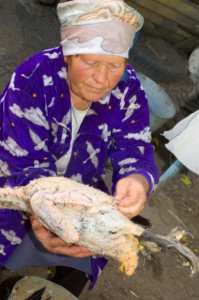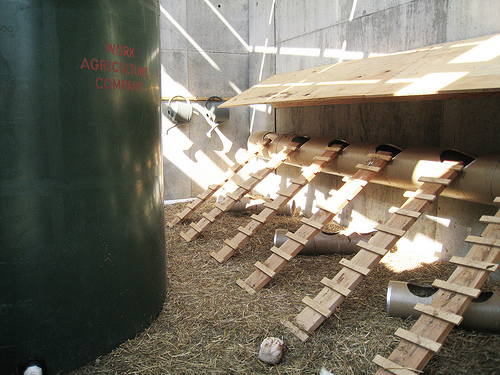Killing What You Eat: The Dark Side of Compassionate Carnivorism
There’s a relatively new category of conscientious consumer on the rise known as the “compassionate carnivore.” These are meat eaters who have chosen, with good reason, to remove themselves from the horrific practices of factory farming. In her thoughtful book, The Compassionate Carnivore, Catherine Friend puts it this way:
I believe it’s possible to show compassion for animals and still eat them. For me, this means paying attention. It means learning more about the animals I eat and taking some responsibility for their quality of life.
A significant number of meat consumers have taken this message seriously enough to become meat producers. Indeed, the urban homestead movement in particular has inspired untold numbers of urbanites to take compassion to the extreme and become part-time animal farmers themselves.
The rationale for this transition is multifaceted, and often quite convincing. “Those of us that raise our own animals,” one of my critics concisely points out, “are doing so because we don’t want to be part of the industrialized agricultural machine that routinely abuses animals for the sake of the almighty dollar.” An urban homesteader from Oakland went one further: “the level of appreciation for nature and life when you slaughter your own meat creates a kind of ethic that I think is what we need to save the world.”
Saving the world notwithstanding, the idea that decentralizing animal agriculture leads to greater animal welfare seems sensible enough. But does that mean serious animal suffering will be avoided? Hardly. An animal can be raised with care, fed a healthy diet, lavished with human affection, and kept relatively safe from external threats. However, more often than not, that animal is still going to be slaughtered. Putting aside for now the ethical implications of killing a sentient being in order to eat well, I want to ask a more tangible question: will the animal be slaughtered with compassion?
Please note: the point here is not to embarrass or castigate urban homesteaders who have boldly sought to take control of their own meat supply. Although I personally find the prospect of raising and killing an animal with my own hands to be deeply saddening, I admire these farmers for being deliberate with their lives and bucking the industrial meat system. My point, instead, is to draw on the published blogs of these (mostly urban) pioneers to highlight the rarely publicized fact that when amateurs take charge of the slaughter, the consequences can be anything but compassionate. Nobody can accurately say how representative the following accounts are, but their popularity suggests that, at the least, they’re not exceptional.
Consider the handiwork of “Poor Girl Gourmet,” upon the slaughter of her first chicken:
We researched humane slaughter practices, including chicken hypnosis, however, the practice round of hypnosis failed miserably, and we came to believe that piercing the chicken’s brain would be the least traumatic for all involved. Not so. On that fateful day, JR [her husband] placed the chicken into the cone, where it promptly attempted to somersault its way out of The Guillotine, clawing furiously at the sloping plastic walls, pushing its head up as though it might get to see the sun again. JR took a pair of sharp scissors – this is a judgment call we lived to regret; despite having an ice pick given to us for this very purpose, we went with the alternative sharp scissor implement. As it turns out, the chicken brain is a very small target, and one that is easily missed. I went from enthusiastic documentary photographer to gagging wife in the span of approximately a half a second. With camera now useless, and my retching instinct fully intact, JR grabbed his sharpened hedge trimmers. Oh, if only they were truly sharp, those sharpened hedge trimmers. The trimmers did not succeed in lopping off the head of the poor, tortured chicken. Instead, they folded its neck over itself in a zig-zag crease, which did, at least, succeed in breaking its neck, and therefore killing it.
Later in the post she recalled that the botched slaughter “was less horrible than what I could conjure up in my crazy little head.”
Responding to a post seeking advice about backyard duck slaughtering on the blog High Desert Chronicles (“sometimes you need to look back to move forwards”), “Heather” forthrightly recounts the difficulties of self-slaughtering quail:
And I won’t lie, it wasn’t easy. I was shaking so badly on the first one I was afraid I’d cut myself with the knife I was using to skin them. It’s a little gruesome if you think too hard about it–there are details I wasn’t emotionally prepared for, which I’m about to talk about so if you’re reading this comment and feeling squeamish you may want to skip to the next one…Some of the difficult details: the way it moves around after the head is gone, and the times when the head doesn’t come off cleanly, and the time when I picked one up to skin it and it started jumping around again after I stuck the knife in it (it was headless). And, when you’re first getting started, the fact that you are likely to make mistakes and one or two may not go as smoothly as you would like, and there may be suffering involved. It’s easy to feel really awful and guilty about it too, because you know if you had only been more skillful or quicker or stronger that the death would have been quick and painless…
On the website backyardchickens.com, “Cathy” left another sad account of botched butchery:
I processed my very first cockerel, the other day, and even though I had spent quite a bit of time studying the jugular method (all of the videos make it looks so simple) it wasn’t so simple finding that vein after all . I cut under the earlobe but now I think that I was supposed to be under the jaw, close to the earlobe. Anyway, I’m still feeling depressed about how I botched the job when all I wanted was to make it as quick and painless as possible for the poor guy.I was also wondering if I was cutting on the wrong side of the head. Does it make a difference? I know there are veins on either side but not sure if they are the same and if one will bleed them out faster than the other. I still have over 20 more cockerels to process this coming week and I’m having bad dreams about it.
Whereas Heather’s and Cathy’s accounts are clearly emotionally-laden recollections intended to help others avoid similar mistakes, others are disturbingly cold in tone. Take this account of killing ducks in the backyard:
Here’s how we did it: Each duck was placed upside down in a cone, held securely by quiet helpers and humanely slaughtered with a sharp razor blade to the artery and vein in the neck. Two passed quickly, two held out for almost 10 minutes with some thrashing and splattering of duck blood.
Her reaction to the two ducks who were not “humanely” slaughtered: “Good thing I wore old pants and sneakers.”

(Hemera)
Which brings me to my final point. Botched slaughters might very well be relatively rare. Who knows? But, for the sake of argument, let’s imagine that compassionate carnivores eventually, after a lot of trial and error, do in fact become universally competent, or “humane,” slaughterers. Even if this happens, I would contend, the emotional distance required to consistently kill animals—often one that you’ve raised–would eventually mitigate the compassion that so many carnivores claim to seek in the first place. Again, to the blogs:
Writing in “Hunt. Gather. Love.,” the blogger Melissa describes the experience of slaughtering her first chicken. The bird she killed was a common industrial breed raised on a small farm. Admitting that there was no science to back up her claim, Melissa explained: “I think there is something wrong with eating food from an animal that is so far away from actually being an animal. As my chicken struggled weakly to escape, I thought about how it never ever would survive in the wild. It was more machine than animal.”
She then took solace in one of the more bizarre rationalizations of unneccessary death I’ve ever heard. For “animals that lived with dignity . . . death is only one day.” I’m not sure how to characterize such a remark, but compassion doesn’t really jump to mind.
A vet in Florida named Patty recounted having to kill her Rooster, named Elvio, because of “his four AM vocal expressions.” She recalled how “he would sit next to you in the evenings and have his waddle stroked.” The author noted that she’d become an experienced chicken killer in vet school. And then she turned her attention to Elvio the Rooster. Here’s how the lights went out for Elvio:
I made it fast, surprising myself with a long repressed chicken-killing efficiency. From a quiet, roosting bird to a dead bird in under three seconds. Some flapping. Then nothing. And that’s when the dirty work really began. But, by then, it wasn’t Elvio anymore. It was just another chicken headed to the pot.
As one reader reacted: “Dead is dead.”
What strikes me most about Melissa and Patty’s respective accounts is how easily the slaughter is rationalized. Melissa reduces her bird to a machine-like creature. Patty effectively erases all memory of her pseudo-pet rooster in three seconds (“it wasn’t Elvio anymore”). Is this the kind of compassion concerned carnivores are seeking?
I doubt it. These examples thus suggest a possible paradox at the core of compassionate carnivorism. On the one hand, it makes perfect sense to think that compassion would be maximized when the consumer turns his own animal into his own meat. On paper, this sounds great. But the logistics and quiet psychological impact of this process—factors that the examples in this post point to– are such that genuine compassion is (perhaps necessarily) going to be compromised.
Of the scores of urban homesteading blogs that I’ve been reading, only one cuts to the core of this concern. It comes from Original Country Girl, who writes:
The best advice is to always maintain a distance between you, and those intended for your dinner plate. This makes the butchering much easier if the animal is nothing more than “the black chicken” or “the grey and white goose.” You can care for your critters in a humane and respectful way without allowing attachments to form. Rule number one is to never give it a name. Some people can get by with ironic names like the afore-mentioned ”Christmas dinner” moniker, but for others even this can cause trouble later on. If you know you’re soft-hearted don’t do it. Clean the pen, feed good feed, and tend any wounds but don’t get too close. No names, no handfed treats, and no special treatment for any one individual animal.
Perhaps the only true compassion a carnivore can experience, in the end, is compassion at a distance. And what sort of compassion is that?


Comments